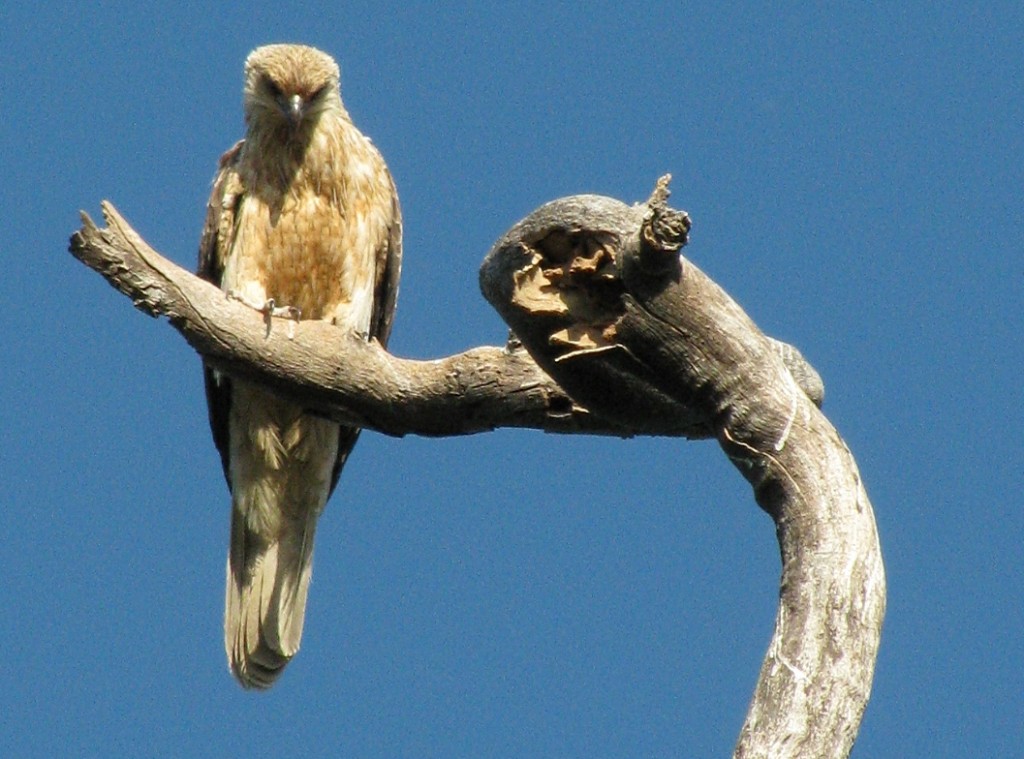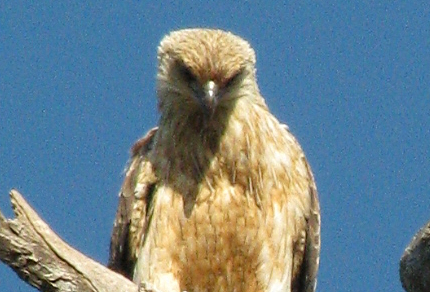
Whistling Kite at Fairfield Waters Wetland, Idalia (© Magi Nams)
After breakfast, I cyled to the nearby suburb of Idalia in Townsville’s east end, my intention to visit the Fairfield Waters wetland. In late May and June, the wetland had been rich with avian life, hosting a nesting colony of little black cormorants and royal spoonbills that had filled, the air with hissing cries of young begging for food, while large flocks of Australian white ibises haad foraged on the wetland shores.
On my arrival, I discovered the wetland empty of cormorants and spoonbills, although a solitary white ibis slunk along the shoreline of the drying wetland. Soil adjacent to the water was completely hidden by herbs grown tall and rank in the absence of trampling avian feet. The nest trees still retained shaggy leaf nests, but these were now abandoned. Peaceful doves and a willie wagtail perched on boughs of one nest tree, the wagtail giving its presence away with a volley of scratchy, rasping calls. As I scouted the trees, a whistling kite flew to a stick nest in one canopy, indicating that this species of kite, which had cohabited the wetland with the cormorants, ibises, and spoonbills, was still in residence.
I crept along the path adjacent to the wetland, spotting a helmeted friarbird basking in the sun atop a leafless tree, a sacred kingfisher which joined the doves and wagtail in the nest tree, and immature and adult yellow honeyeaters. The last I took as good evidence that the territorially-defensive pair of yellow honeyeaters I’d spotted in earlier visits had successfully reared young. A white-bellied cuckoo-shrike sneezed out its “kussick!’ call, and a single anhinga rested in a rain tree overhanging the wetland, where on past visits I’d seen a half dozen or more with drying wings artistically extended. Undoubtedly, the wetland has entered a quieter, less-populated phase. I wondered if future months would bring an even greater decrease in activity, or if a new suite of birds would enter the scene.
Leaving the wetland, I cycled along a portion of the Ross River winding its way through Idalia downstream from the Bowen Road bridge. I spotted river hunters wading or flying darting paths, the latter welcome swallows floating on long wings and forked tails, the former a white reef egret that snatched a blue fish from the river, and an intermediate egret and Australian pelican standing so close to each other they appeared to be chatting over breakfast.
Today’s birds: peaceful doves, magpie-larks, blue-faced honeyeaters, mynas, rainbow lorikeets, masked lapwings, bush stone-curlews, house sparrow, figbirds, great bowerbirds, pied butcherbird, Australian magpies, brown honeyeaters, white-bellied cuckoo-shrike, helmeted friarbird, sacred kingfisher, welcome swallows, rainbow bee-eaters, anhingas, yellow honeyeaters, whistling kites, willie wagtail, little corellas, Australian white ibis, rufous-throated honeyeater, cattle egrets, pheasant coucal, spangled drongos, white-gaped honeyeaters, reef egret, little black cormorants, Australian pelican, intermediate egret.


